Objective:
To screen effective, competitive and host broad spectrum of common bean and chickpea rhizobia for use in African soils.
Main activities:
- Screening effective strains from local collections using Modified Leonard Jars and/or isolating new strains using plant-trapping method and screening of the isolates for effectiveness
- Factorial combination of host varieties with effective rhizobial strains to select both effective rhizobia and appropriate host variety in terms of effective symbiotic interactions. Analysing the patterns of G x G interaction in relation to geographic/genetic co-evolution and nod-C variants and compatibility with certain host genotypes
- Mix strains and test them against host varieties in greenhouse on soil containing pots and on Modified Leonard jars and genomically determine nodule occupancy (testing competitiveness)
- Screened legume variety and rhizobium strain will be evaluated under field conditions to see their competitiveness and effectiveness
Method:
In order to screen effective rhizobium strains for G x G interaction study, two series of experiments were established. The first experiment included 20 common bean and 28 chickpea strains obtained from Hawassa University soil microbiology laboratory and Norwegian University of Life Sciences. Habru chickpea and Nasir common bean varieties were used for screening the strains. The experiment was conducted on modified Leonard jars in a lath-house. 1 ml of each strain was inoculated to the base of the legume varieties’ growing on the jars. Positive controls contained non-inoculated seedlings that were supplied with N-free nutrient medium and 0.5% KNO3 and the negative controls contained non-inoculated seedlings that were only supplied with N-free nutrient solution. Commercial and type strains were included for comparison purposes. All the seedlings were completely randomized and supplemented with Jenson’s N-free nutrient medium and grown in the lath-house for forty five days. The seedlings were carefully uprooted and examined for nodulation and effectiveness. The second series of experiment was set with the same design as above but with additional number of strains and Natoli chickpea variety instead of Habru. The total number of strains that was set for common bean is 65 and 61 strains for chickpea.
Results:
The first experiment had quite astounding result for chickpea strains, i.e., all the strains were failed to elicit nodules on the roots of the Habru variety. The seedlings formed yellowish patterns on their leaves, which was unusual character. The roots of the seedlings were observed to be decaying or rotting. These symptoms were not due to nitrogen deficiency rather they might be due to high temperature of the lath-house, noticed during the period of the experiment. This phenomenon was noticed in the previous works (Wondeson and Endalkachew, personal communication). Therefore; it can be said that the high temperature of the lath-house was able to abort the inoculated strains. On the other hand, it means, the strains failed to perform under high temperature.
Common bean seedlings inoculated with the strains formed nodules on their roots. The Mexican strain (CH24-10) formed the highest number (91) of nodules (data not shown). When cut and examined, the nodules had pinkish internal colour but the leave colour of the seedlings were yellowish for all, except for the positive controls. Similarly, the shoot dry weight of the negative controls and the inoculated ones were the same. There was a significant difference between the shoot biomass of the inoculated seedlings and the positive controls. Thus, this was forced us to decide that the strains was not effective and might be affected by the high lath-house temperature for which we designed the second experiment to carry during a cool season.
The result of the second experiment was better than the first one. Out of the 65 strains, CIAT 899, CH24-10 (Mexican), HB429 (local), NAK 91, NAK 103 and NAk 104 (Kenyan strains) produced green leave colour of common bean while the others produced yellowish leave colour (Figure 1). The shoot dry weight of those seedlings were higher than the rest, except for positive controls. The highest shoot dry weight was recorded for the positive controls (Figure 2). Nodule number (removed from graph, Figure 2) could not be an indicator for effectiveness of the strains (Figure 3). Because, they did not correlated with the shoot weight measured.
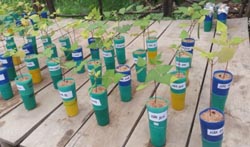 |
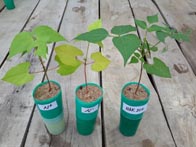 |
 |
| Figure 2: Shoot, root and nodule dry weight (on y-axis) of Nasir common bean variety inoculated with rhizobium strains (on x-axis). N- is negative control, which was not inoculated and supplemented with 0.5% KNO3 while N+ is positive control that was not inoculated but supplemented with 0.5% KNO3. SDW = shoot dry weight; RDW = root dry weight and NDW = nodule dry weight. Effectiveness of the strains is determined based on the following criterion: |  |
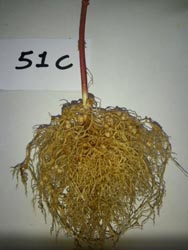 |
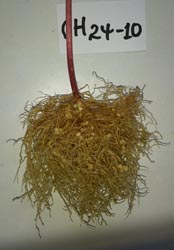 |
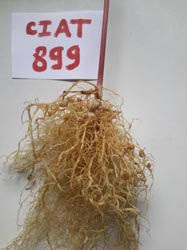 |
Figure 3: Common bean nodulation assessment
The chickpea seedlings did not show difference in leave colour (Figure 4) but their shoot height and vigour were very variable. M7, M4b, M20a, M20, CP130, CP67 and CP65 strains produced better shoot dry weight and plant vigour than others (Figure 5). The commercial strain CP113 was not able to form nodule and the original strain might be dead or it might be mutated over time and become unable to nodulate. Examples of nodules for effective strains are indicated in figure 6.
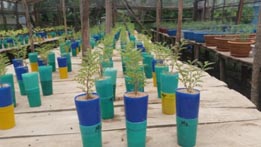 |
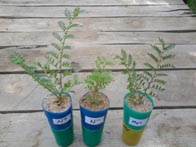 |
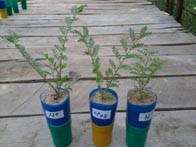 |
Figure 4: Response of Chickpea variety to rhizobial inoculations

Figure 5: Chickpea strain performance on Natoli variety. ASDW = Average shoot dry weight; ARDW = average root dry weight and ANDW =Average nodule dry weight
 |
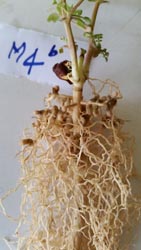 |
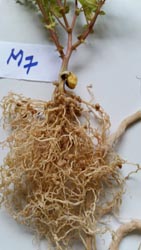 |
Figure 6: Chickpea nodulation assessment
CIAT 899, CH24-10, HB429, NAK 91, NAK 103 and NAk 104 common bean strains and M7, M4b, M20a, M20, CP130, CP67 and CP65 chickpea strains were relatively more effective than others and selected for GL x GR interaction study.
Ashenafi Hailu Gunnabo, Ethiopia, Wageningen University, The Netherlands

